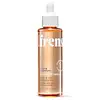Being Frenshe Body & Hair Radiance Oil Versus Shea Moisture 100% Virgin Coconut Oil Daily Hydration Body Oil
What's inside
What's inside
 Key Ingredients
Key Ingredients

No key ingredients
 Benefits
Benefits

 Concerns
Concerns

 Ingredients Side-by-side
Ingredients Side-by-side

Carthamus Tinctorius Seed Oil
MaskingIsopropyl Myristate
EmollientIsododecane
EmollientParfum
MaskingHelianthus Annuus Seed Oil
EmollientIsopropyl Laurate
EmollientIsopropyl Palmitate
EmollientSimmondsia Chinensis Seed Oil
EmollientEthyl Oleate
EmollientEthyl Stearate
EmollientIsopropyl Alcohol
SolventButyrospermum Parkii Butter Unsaponifiables
Skin ConditioningEthyl Linoleate
EmollientEthyl Palmitate
EmollientBenzyl Salicylate
PerfumingLimonene
PerfumingCoumarin
PerfumingBenzyl Alcohol
PerfumingJuniperus Virginiana Oil
MaskingCitrus Aurantium Bergamia Fruit Oil
MaskingCitrus Nobilis Peel Oil
MaskingCananga Odorata Flower Oil
MaskingCarthamus Tinctorius Seed Oil, Isopropyl Myristate, Isododecane, Parfum, Helianthus Annuus Seed Oil, Isopropyl Laurate, Isopropyl Palmitate, Simmondsia Chinensis Seed Oil, Ethyl Oleate, Ethyl Stearate, Isopropyl Alcohol, Butyrospermum Parkii Butter Unsaponifiables, Ethyl Linoleate, Ethyl Palmitate, Benzyl Salicylate, Limonene, Coumarin, Benzyl Alcohol, Juniperus Virginiana Oil, Citrus Aurantium Bergamia Fruit Oil, Citrus Nobilis Peel Oil, Cananga Odorata Flower Oil
Helianthus Annuus Seed Oil
EmollientPrunus Armeniaca Kernel Oil
MaskingPrunus Amygdalus Dulcis Oil
Skin ConditioningSimmondsia Chinensis Seed Oil
EmollientParfum
MaskingOlea Europaea Fruit Oil
MaskingTocopheryl Acetate
AntioxidantButyrospermum Parkii Butter
Skin ConditioningCocos Nucifera Oil
MaskingAcacia Senegal Gum
MaskingCocos Nucifera Fruit Juice
EmollientCocos Nucifera Fruit Extract
EmollientWater
Skin ConditioningGlycerin
HumectantHelianthus Annuus Seed Oil, Prunus Armeniaca Kernel Oil, Prunus Amygdalus Dulcis Oil, Simmondsia Chinensis Seed Oil, Parfum, Olea Europaea Fruit Oil, Tocopheryl Acetate, Butyrospermum Parkii Butter, Cocos Nucifera Oil, Acacia Senegal Gum, Cocos Nucifera Fruit Juice, Cocos Nucifera Fruit Extract, Water, Glycerin
 Reviews
Reviews

Ingredients Explained
These ingredients are found in both products.
Ingredients higher up in an ingredient list are typically present in a larger amount.
Helianthus Annuus Seed Oil is the oil derived from the seeds of a Sunflower. Sunflower seed oil is non-fragrant. It is an emollient, meaning it helps to soften the skin.
Sunflower seed oil contains many fatty acids. The fatty acids found in sunflower seeds include (from highest amount to least): linoleic acid, myristic acid, palmitic acid, stearic acid, arachidic acid, oleic acid, and linolenic acid.
These fatty acids help the skin create ceramides. Ceramides play a role in repairing the skin barrier.
Helianthus Annuus Seed Oil helps moisturize the skin. This in turn helps the skin look more rejuvenated and smoother.
Sunflowers are rich in vitamin E.
Historians believe Indigenous cultures of North America domesticated sunflowers before corn. Thus they relied on sunflower oil for a variety of uses. One such use is moisturizing skin and hair.
Sunflower seed oil may not be fungal acne safe. We recommend speaking with a professional if you have any concerns.
Learn more about Helianthus Annuus Seed OilParfum is a catch-all term for an ingredient or more that is used to give a scent to products.
Also called "fragrance", this ingredient can be a blend of hundreds of chemicals or plant oils. This means every product with "fragrance" or "parfum" in the ingredients list is a different mixture.
For instance, Habanolide is a proprietary trade name for a specific aroma chemical. When used as a fragrance ingredient in cosmetics, most aroma chemicals fall under the broad labeling category of “FRAGRANCE” or “PARFUM” according to EU and US regulations.
The term 'parfum' or 'fragrance' is not regulated in many countries. In many cases, it is up to the brand to define this term.
For instance, many brands choose to label themselves as "fragrance-free" because they are not using synthetic fragrances. However, their products may still contain ingredients such as essential oils that are considered a fragrance by INCI standards.
One example is Calendula flower extract. Calendula is an essential oil that still imparts a scent or 'fragrance'.
Depending on the blend, the ingredients in the mixture can cause allergies and sensitivities on the skin. Some ingredients that are known EU allergens include linalool and citronellol.
Parfum can also be used to mask or cover an unpleasant scent.
The bottom line is: not all fragrances/parfum/ingredients are created equally. If you are worried about fragrances, we recommend taking a closer look at an ingredient. And of course, we always recommend speaking with a professional.
Learn more about ParfumThis oil comes from the seeds of the desert shrub called Jojoba. It is more commonly known as jojoba oil, a non-comedogenic oil.
Jojoba oil does not contain fragrance and has many fatty-acids, making it a great soothing ingredient.
It also contains Vitamin E, a great moisturizing ingredient. Vitamin E is also an antioxidant and protects your skin against oxidative damage.
This ingredient humectant properties, meaning it helps draw moisture from the air. This helps keep your skin hydrated.
While jojoba has antibacterial properties, it is only able to kill some strains of bacteria.
Studies also show it helps in wound healing. In fact, Indigenous cultures have used jojoba as a moisturizer and to help treat burns for centuries.
Fun fact: Jojoba oil similar to natural human skin sebum, so it has a great effect on dry skin. It is also promising with helping to regulate sebum production.
Due to its fatty acid content, Jojoba oil may not be fungal acne safe. We recommend speaking with a professional if you have any concerns.
Learn more about Simmondsia Chinensis Seed Oil